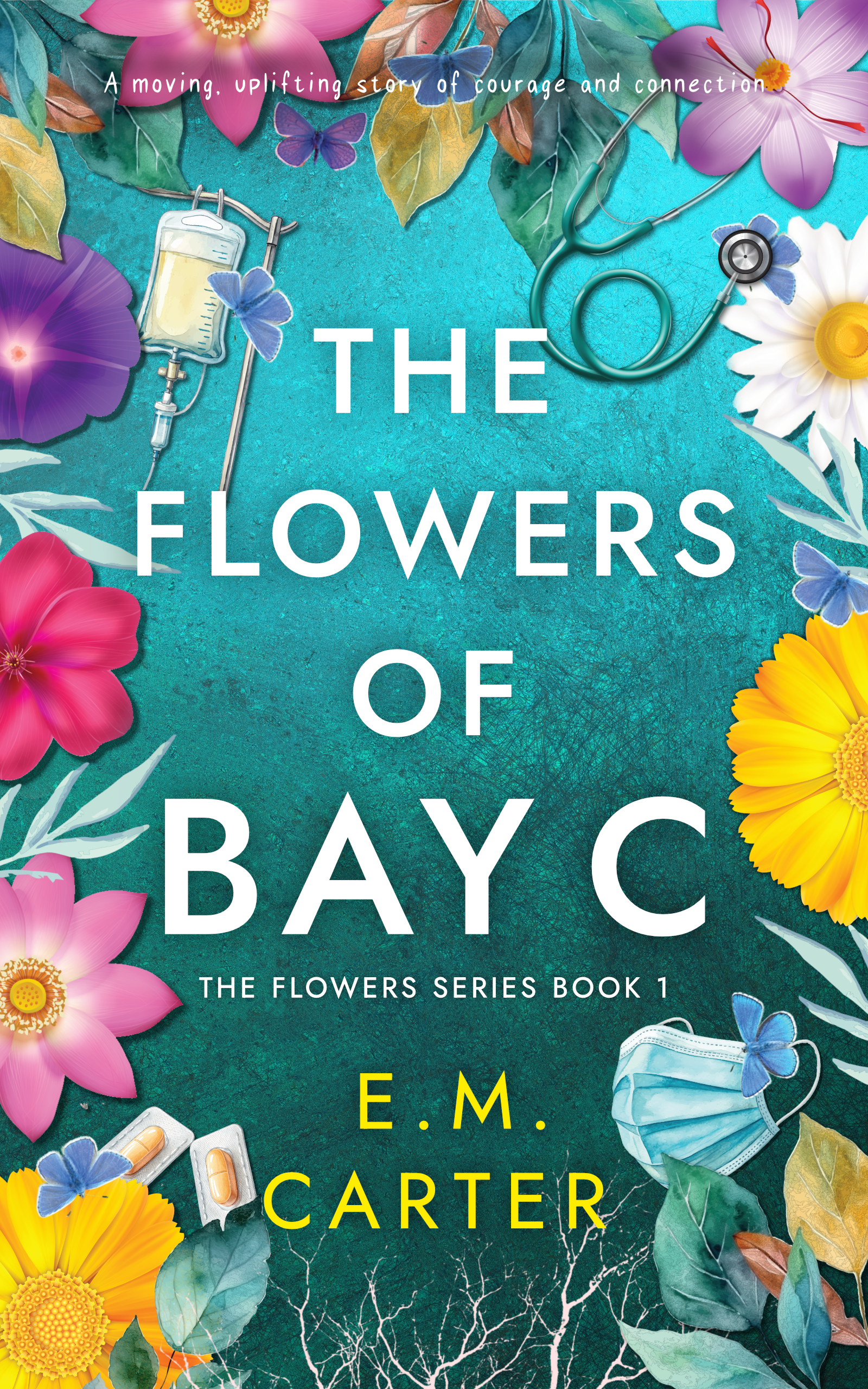Blooming through Friendship: An interview with author E.M. Carter
Jo Acharya & EM Carter | November 28, 2025
I’ve known E.M Carter (Liz to her friends!) for a while now and loved her book Valuable, which dug deeply into our innate worth as precious people made in the image of God and loved by him. (Read my review of Valuable here.) Liz and I share some experiences in common: we both live with longterm lung conditions and the limitations that chronic illness brings. We’re also both Christians, and through our writing explore what it looks like to walk faithfully with Jesus through all the joy and pain of everyday life.
Liz has since moved into fiction, and the setting of her moving new novel, The Flowers of Bay C is one that will be foreign to many, but very familiar to others: a hospital inpatient ward, a place no one wants to be, yet one that for some of us is almost a second home.
Six women meet on this ward, connected at first only by illness. Though they are very different, their shared experience coaxes them to open up and gradually bloom in the soil of unlikely friendship and a daring new mission.
This is a lovely, richly textured story that doesn’t shy away from suffering and loss, but has hope at its heart. Liz’s beautiful writing points toward the healing power of friendship, and along the way scatters bright glimmers of the abundant life to be found in Jesus.
I’ve reflected a lot on the intersection between faith and illness in my own life, and written about trusting God through suffering in my books Refresh and Glimpsing Grace. Liz has kindly answered some of my questions and shared her own insights into this topic too – I hope you find her hard-won wisdom as encouraging as I do.

You’ve written Christian non-fiction and poetry (as Liz Carter), as well as a series of dystopian fiction for young adults, and now this very different novel. What are the common threads that run through your writing, and how have you explored them in different ways?
My heart has always been to explore the value we all hold as humans created in God’s image, and how we don’t need to earn God’s love – or the love and regard of others – through what we ‘do’ and achieve.
My non-fiction books are written for the Christian market, and as well as focusing on our identity in Christ, they dig for treasure in the midst of life’s pain. And my previous fiction books are in the dystopian genre: The Newland Trilogy, where I write about a world that judges people only on how productive they are and how much economic value they give to the nation. These are written for the wider secular market, and my hope is that they speak to people of their infinite value – and, in subtle ways, of the love of God.
Can you tell us a little about The Flowers of Bay C, and the group of unlikely friends at the heart of the story?
I always love to explore what makes people tick, and especially within friendships made in difficult or crisis situations. So in Flowers, six women meet on one hospital bay – six very different characters with different life experiences. There’s Penny, done with illness and with being a people pleaser while feeling like a burden; Barbara, eighty-seven and desperate to see the sea one last time; Jodie, all laughter and hidden pain; Kat, the tattooed vicar who never puts herself first; Violet, proud and prickly; and gentle Amina, who sees the truth in everyone else.
I love bringing people together who usually wouldn’t connect, and seeing what happens – and, in hospital, unlikely friendships are so often made. They come together to try and fulfil Barbara’s last wish – and maybe they’ll save themselves in the process…
Like your main character, Penny, you and I both live with long-term health conditions. I related to many of your descriptions of hospital life! How much of your own experience went into the book, and what do you particularly want to communicate through it?
I must admit that this book has been very much written out of my own experience of frequent hospital stays throughout my life. I first got the idea when chatting to a wonderful group of women on my bay on one particular stay – it got me wondering what that would look like as a fully fleshed out story of resilience, compassion, and even mad adventuring. In the book there’s a lot of description of the indignities and absurdities of hospital life, and I’m sure that those who know it intimately will raise a smile at some points and a grimace at others!
I also hope that readers who don’t know hospital settings will find themselves transported there and enjoy the developing characters and their story. I really wanted to express what it is like to live with chronic illness in order to both communicate my empathy to those who suffer and to draw others in to the reality of it.
I love how individual the women in this book are. They all deal with their challenges in different ways and come across as real, complex characters with full lives. How important was it to you to show them as strong and vibrant women while also revealing their flaws and vulnerabilities?
Thank you! I wanted to tell a good story while also showing the realities of life and the complexity that makes up all of us. I’ve read books where characters are either all perfect or all bad, and for me that doesn’t quite work because we’re all a little bit messy, a little bit broken, and often there’s a story behind particular behaviours.
For example, we’ve got prickly Violet, who behaves like the world has a grudge against her and she complains about everything – yet friendship makes her bloom and brings out something of what makes her feel the way she does – and helps her move forwards in new and positive ways.
Yes, I really enjoyed seeing the women learn and grow through the support they give each other. How important do you think it is to have friends who both encourage and challenge us? And how can shared experience create a bond between people who are otherwise very different?
I think we all need friendships like the women in this book: messy, compassionate, funny, thoughtful, giving, sometimes challenging friends who bring out the best in us. It’s important that we try to be those kinds of friends to others, too; to look out for others around us and offer the warmth of welcome, listening and understanding.
And when we share a crisis experience with others, the bonds are often even stronger, because there is something very profound about sharing with those who really get it. I’ve found a real depth of friendship with those who have the same disease as me, although I’d never have met these friends if not for the disease and we’re all very different. Adversity can create a strength of belonging when others are walking the same path – and that can be so very soothing when life hurts.
There are glimpses of faith in the character of Kat, whose illness is sudden and unexpected. What role has your faith played in your own journey, and how would you encourage someone who is encountering illness or an uncertain future for the first time?
My faith has been instrumental in my own journey of illness and pain – and, at times, it’s been difficult too, in terms of resolving ongoing pain with a God who loves me (I’ve explored a lot of that in my non-fiction books Catching Contentment and Valuable). But I’ve found such profound healing in the knowledge that Jesus – who suffered and died for me – walks this journey with me and understands my pain. I’ve found there’s treasure to soothe and to empower and even bring joy in the midst of the worst of pain.
So I’d encourage those who are struggling with this kind of thing to look to God even when it seems impossible to find him, to look for his quiet Spirit resting on them and weeping with them, to remind themselves of his great love for them and how valued they are. And, in the end, to take hold of hope for a future where there will be no more mourning, crying, death or pain.
That’s so helpful. For readers who enjoy The Flowers of Bay C, can you recommend some other novels to check out?
I’ve not come across another novel set in a hospital like this, but there are others in this same genre – uplifting women’s book club fiction – that explore similar dynamics of unlikely friendships in difficult situations. The Lido by Libby Page, The One Hundred Years of Lenni and Margot by Marianne Cronin, and The Authenticity Project by Clare Pooley all pick up these kinds of themes and are very much worth a read!
Thank you Liz. And finally, what are you working on now? Do you have projects in the pipeline?
Yes! I’ve just finished writing a prequel to my dystopian trilogy, which will be out in late spring 2026 with Resolute Books. I’ve also started working on a new advent devotional for next Christmas, so watch this space!


E.M. Carter is a writer and poet from Shropshire, UK. She is the author
of several novels and non-fiction books including Valuable: Why Your Worth is Not Defined by How Useful You Feel and the Newland trilogy. You can find her on Instagram, Facebook, TikTok and X @lizcarterwriter or at her website, emcarter.carterclan.me.uk.
(All the Amazon links on this page are affiliate links, so I may earn a small commission if you make a purchase.)
Join our community
Sign up for bonus content, special offers and free gifts!

